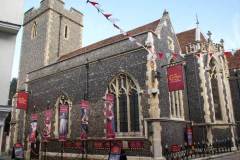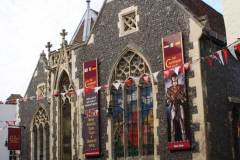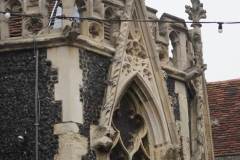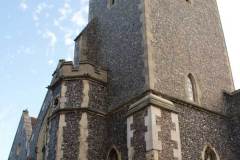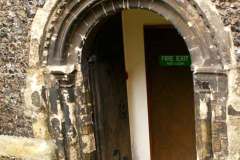St Margaret’s Street
Introduction
St Margaret’s is now a redundant church, but was probably the most visited church in Canterbury in its recent role as an audio–visual tourist attraction based on Geoffrey Chaucer’s “Canterbury Tales”.
History
St Margaret’s church was founded in the 12th century, though much of the present structure dates from the 14th century when it was developed as a perpendicular style 3 aisle church with a stone and flint exterior. In 1791 the chancel and eastern end of the aisles were truncated to allow horse drawn coaches to swing into the gate of the prestigious Royal Fountain Hotel exactly opposite. Around 1850 the interior was refurbished in the Victorian style, the pitched roofs added to the aisles and the chancel developed into the polygonal form that can be seen today by Sir Gilbert Scott. It became redundant in 1942 and was a church for the deaf until being converted into the Canterbury Tales visitor attraction in 1986. Since then the interior has been completely obscured by the exhibition, but photographs from 1942 of the original church can be accessed at the link below. These include an image of a monument to William Somner, the famous Canterbury historian and compiler of the first Anglo-Saxon dictionary, who died in 1669.
What to see:
- The exterior of the church showing the perpendicular windows to the south wall (Image 1).
- The eastern end of the church showing how precisely the nave and aisles have been truncated to the revised street line (Image 2).
- The highly decorative neo-gothic polygonal eastern apse from 1850 (Image 3).
- The western facade and perpendicular tower with a Victorian external staircase (Image 4).
- The only remains of the original mid 12th century church is the heavily restored Romanesque west door (Image 5).
Access: The church can be viewed externally at all times, but the interior is now completely obscured.
Update June 2023
The graveyard round the back has been closed for some time and inaccessible to the public. However the church commissioners are proposing to sell the graveyard (now deconsecrated) to a developer (Sethia) to be used as a community access space in proximity to the new development of housing proposed on the former Nason’s site. The deadline for receipt of comments for or against this proposal in June 19th 2023 and the best way to send comments is by email to rex.andrew@churchofengland.org.
Sources: Lyle (2008); Canterbury Archaeological Trust Annual Report 1985/86
SR

